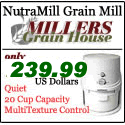|
|
Picture Perfect Bread
Dennis R Weaver
The secret—at least most of it—is in the rise. The most common mistake that we see in bread making is not letting the dough rise enough.
So how do we know when the bread has risen enough? The dough will double in size. It will be soft and look a bit airy. When you touch it with your finger, it will feel soft and an indention in the dough will remain. If it feels a bit springy and the dough bounces back from the indentation, it hasnÂ’t risen enough.
To help you tell when your bread has risen enough, most recipes tell you how long to let the bread rise at normal kitchen temperatures. (The stated time is a guideline but itÂ’s usually pretty accurate if you are using water at the recommended temperature. Set the timer and forget about the bread until you hear the timer.)
Can you let bread rise too much? Yes—but most of us are too impatient to let that happen often. If it does rise too much, it will be blistered, so soft it won’t hold its form, and may even collapse. No problem. Just gently knead some of the air from the dough, reshape the loaves, and let it rise again. It will rise more quickly the second time.
Sometimes, the bread dough is too dry or too wet. That wonÂ’t happen often if you carefully measure the water. Traditional bread dough will be soft and barely sticky but dry enough to handle with a little flour on your hands. Environmental conditions, such as humidity or water hardness, may affect the moisture in the dough. If you feel that your dough is too wet or dry, add another tablespoon or two of flour or dribble in a tablespoon of water.
One more thing—when you put your loaves into the oven, allow as much space as possible between the loaves and between the loaves and oven walls. If air can’t circulate properly around the loaves, the loaves will be misshapen.
Baking bread is an art. With a little practice, anyone can have picture perfect bread. Even when it is not picture perfect, it is a treat to enjoy.
Dennis Weaver is the general manager at The Prepared Pantry (www.preparedpantry.com) with recipes, ideas, and the best selection of mixes and ingredients. Visit the free Bakers' Library for more articles like this, free baking guides, and tested recipes.
|
Our Food Supply is in Peril! Watch this
Video...
WE RECOMMEND

Here are even more informative articles on milling grains and whole wheat.
The Goods on Sourdough
Foccacia - A Healthy Food Trend of the New Millennium
Breadmaker Recipes
The Health Benefits of Oats
Milling Grains - Cost and Storage Benefits
Whole Grains Prevent Weight Gain

Nutrimill
Multi-Texture High Speed Grain Mill
BEST
PRICE Available! New and innovative
variable high speed grain mill. Mill grains and beans
into fresh flour in minutes. Get
More Information and Secure ORDER HERE See
Our Special! |
|